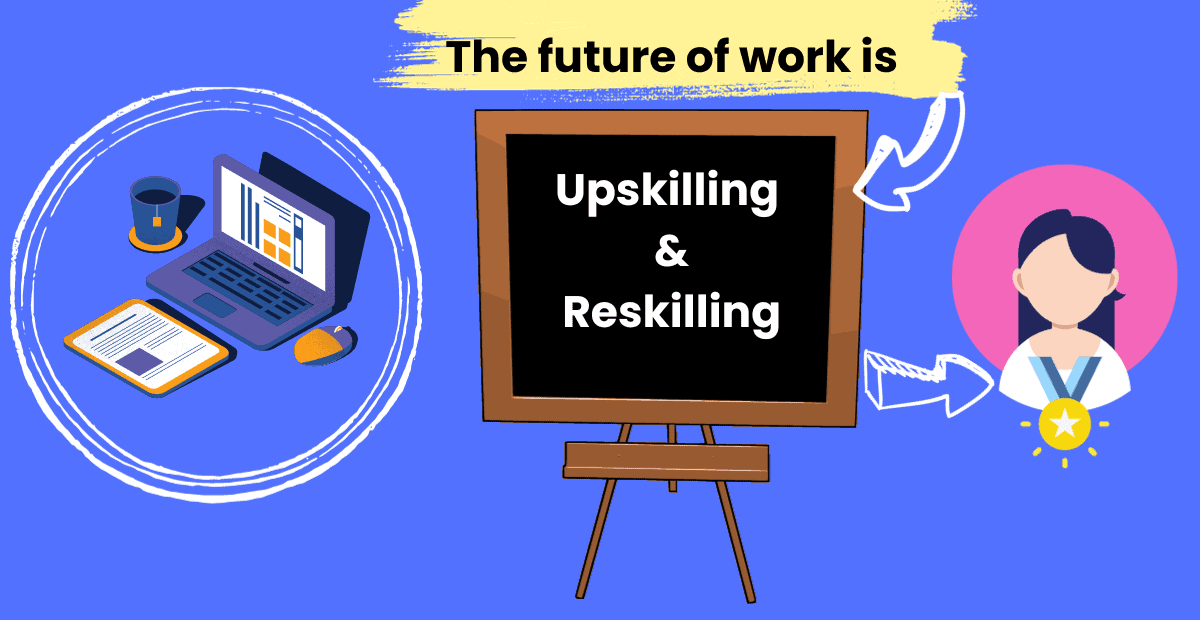How To Use Technology To Upskill And Reskill For The Future Of Work

Table of Contents
Key Takeaway
- Continuous upskilling and reskilling are imperative in today’s dynamic job market, driven by digital transformations and emerging technologies.
- Professionals must adapt to evolving job roles, address skill gaps, and acquire in-demand skills to remain relevant and competitive.
- Online learning platforms offer flexible, affordable, and accessible options, empowering individuals to learn at their own pace and schedule.
- Virtual reality (VR) and artificial intelligence (AI) enhance hands-on training and personalize learning paths, contributing to more effective skill development.
- Social media platforms play a vital role in skill-building and networking, providing diverse resources and opportunities for continuous learning and adaptability.
1. Understanding the Importance of Upskilling and Reskilling in the Future of Work
In today’s fast-paced and ever-changing job market, it’s become increasingly essential to continuously upskill and reskill to remain relevant and competitive.
Were you aware that by 2026, up to 1.4 million workers will require reskilling? Notably, 70% of these workers will undergo this transformation due to the cessation of their current job type.
With the digital transformation the norm, new job roles are constantly emerging while others are becoming obsolete. This means that professionals must continuously adapt to keep up with the demands of the future workplace.
Identifying and addressing skill gaps, acquiring in-demand skills, and fostering a future-ready workforce are vital strategies to navigate the evolving professional landscape.
2. What is Upskilling and Reskilling?
Upskilling refers to learning new skills or improving existing ones within a specific field or industry. It involves staying updated on the latest technologies, tools, and techniques related to one’s current job role.
On the other hand, reskilling involves developing an entirely new set of skills in a different field.
Example: The rise of AI and automation demands new job skills in sectors such as IT and manufacturing. Workers in these industries may need to reskill to transition into new roles.
3. Utilizing Online Learning Platforms for Upskilling and Reskilling
Technology makes accessing a wide range of learning resources online easier. Online learning platforms such as Coursera, Udemy, and LinkedIn Learning offer many courses and tutorials on various topics and skills. These online platforms allow upskilling programs, enabling working professionals to balance their job responsibilities while learning new skills.
Advantages of Online Learning:
- Flexibility: Individuals can learn at their own pace and schedule.
- Affordability: Many online courses are more affordable than traditional classroom-based courses.
- Accessibility: Courses are available from anywhere with an internet connection, removing the location barrier.
- Variety of Topics: A wide range of topics and skills is available on online learning platforms, making it possible for individuals to upskill or reskill in their desired field.
Example: Taking a data science course on Coursera to transition from a traditional marketing role to a more data-driven role.
4. Leveraging Virtual Reality (VR) for Hands-On Training
Virtual reality technology can potentially revolutionize learning and training for new skills. VR allows individuals to experience hands-on training in a simulated environment, providing a safe space to practice and make mistakes without real-world consequences. This type of training can be especially beneficial for industries such as healthcare, where it’s crucial to have practical experience before working with actual patients.
For example, VR can be used for soft skills training, such as public speaking or leadership skills, or simulated job interview scenarios for practice and feedback.
5. Using Artificial Intelligence (AI) for Personalized Learning Paths
AI technology can analyze data from online learning platforms and recommend personalized learning paths based on an individual’s strengths and weaknesses. This customized approach to learning can improve the effectiveness and efficiency of skills development, catering to each individual’s unique needs.
For example, AI recommends specific modules or practice exercises for an individual struggling with a particular concept in an online course.
For example, AI algorithms on LinkedIn Learning suggest relevant courses based on a user’s previous learning history and career goals.
6. Harnessing Social Media Platforms for Skill Building
Social media platforms offer vast resources and communities for individuals to connect, share knowledge, and learn new stuff. Many professionals use social media not only as a source of information but also as a way to network and collaborate with others in their field. With the rise of live streaming and virtual events, social media has become an even more valuable skill-building tool.
For example, Joining LinkedIn groups or Twitter chats related to a specific skill or industry to connect with like-minded individuals and learn from each other.
For example, Attending online workshops or conferences hosted on social media platforms to gain insights and practical tips from experts in various fields.
For example, Using YouTube for self-paced learning skills such as graphic design or video editing.
7. Importance of Continuous Learning and Adaptability in the Age of Technology
Continuous learning and adaptability are essential skills in the rapidly evolving landscape of emerging technology. As new technologies emerge and industries evolve, individuals must stay updated with the latest tools, techniques, and knowledge to remain competitive in the job market.
Technological advancements have increased the demand for technical skills such as machine learning, data analytics, and coding. This has resulted in the rise of reskilling programs that offer training and education to individuals looking to transition into a career in these fields.
These programs often focus on teaching technical skills while providing hands-on experience through practical projects and internships.
For example, IT professionals constantly update their skills to keep up with advancements in programming languages or software development.
For example, Entrepreneurs continually learn about new marketing strategies and digital platforms to adapt to changing consumer behavior.
For example, regularly update coding skills to stay relevant in the rapidly evolving technology sector.
8. Emergence of AI Technology
One of the most significant technological advancements in recent years is the rise of artificial intelligence (AI). AI technology has revolutionized various industries, including healthcare, finance, and transportation.
As AI advances and becomes more prevalent daily, individuals must stay updated with its latest developments and applications.
Example: Attending webinars or online courses on AI technology to learn about its potential uses in different industries.
Example: Learning programming languages like Python or R to build AI models and algorithms.
Example: Following industry leaders and experts on social media platforms to stay updated with the latest trends and advancements in AI technology.
9. Conclusion
In conclusion, we can summarise that;
- Continuous learning and adaptability are vital for personal, employee, and organizational growth, fostering productivity and readiness for the future.
- Utilizing technology, online platforms, and social media has been immensely valuable in facilitating continuous learning.
- Benefits include connecting with like-minded individuals, gaining expert insights, and consistently improving personal and professional development skills.
- Encouragement is extended to others to embrace the potential of social media in their journey toward continuous learning and adaptability in the age of technology.
10. Frequently Asked Questions
Q: Can one learn AI without a technical background?
A: It’s possible to learn AI without a technical background. Many online platforms offer introductory courses in AI that do not require prior technical knowledge. However, a basic understanding of mathematics and logical thinking can be beneficial.
Q: How can social media platforms be used for continuous learning?
A: Social media platforms can follow industry leaders, join professional groups, participate in discussions, share insights, and access rich educational content.
Q: Does continuous learning require a significant investment of time and money?
A: The investment largely depends on one’s learning goals. While some resources are free, others may require a financial commitment. As for time, consistent, dedicated learning sessions, even if short, can lead to considerable progress over time.
Q: What is the significance of upskilling and reskilling for the future of work?
A: Upskilling and reskilling are crucial for the future of work as technology and automation rapidly change the nature of jobs. To remain competitive and relevant in the workforce, individuals must continuously acquire new skills and competencies.
Q: How can technology be used to upskill and reskill the workforce?
A: Technology can be used to upskill and reskill the workforce through online learning platforms, virtual simulations, artificial intelligence, and machine learning tools. These tools provide access to flexible and personalized learning experiences, allowing individuals to acquire new skills at their own pace.
Q: What are the benefits of upskilling for employers and employees?
A: Upskilling benefits employers by ensuring a future-ready workforce with the necessary skills to adapt to technological advancements. For employees, upskilling enhances career opportunities, job security, and overall job satisfaction.
Q: How can businesses prepare for the future by investing in upskilling programs?
A: Businesses can prepare for the future by investing in upskilling programs focusing on digital skills, innovative technologies, and new working methods. By doing so, they can cultivate a workforce equipped to thrive in the digital age.
Q: What is the difference between upskilling and reskilling?
A: Upskilling involves enhancing existing skills or learning new skills related to the current job role, while reskilling involves learning entirely new skills to transition into a different job or industry.
Q: What is the need for upskilling and reskilling in the current and future workforce?
A: The need for upskilling and reskilling is driven by rapid technological advancements and the evolution of job roles. Both current and future workforce need to adapt to the changing skill requirements to thrive.
Q: How can businesses and employees stay ahead by embracing reskilling and upskilling?
A: By embracing reskilling and upskilling, businesses and employees can stay ahead by acquiring the digital skills and competencies required to meet the demands of Industry 4.0 and the future of work.
Q: What role does the World Economic Forum play in shaping the need for upskilling and reskilling?
A: The World Economic Forum significantly shapes the need for upskilling and reskilling by publishing the Future of Jobs Report, highlighting the changing skills landscape and workforce transformation in the digital age.
Q: How can employers and business leaders promote a culture of continuous upskilling and reskilling?
A: Employers and business leaders can promote a culture of continuous upskilling and reskilling by investing in learning and development programs, fostering a growth mindset, and providing resources for employees to acquire new skills.
Q: How can individuals develop the skills for the future of work in the digital era?
A: Individuals can develop the skills for the future of work in the digital era by seeking opportunities for digital upskilling, leveraging online courses, and staying updated on industry trends and technological advancements.
